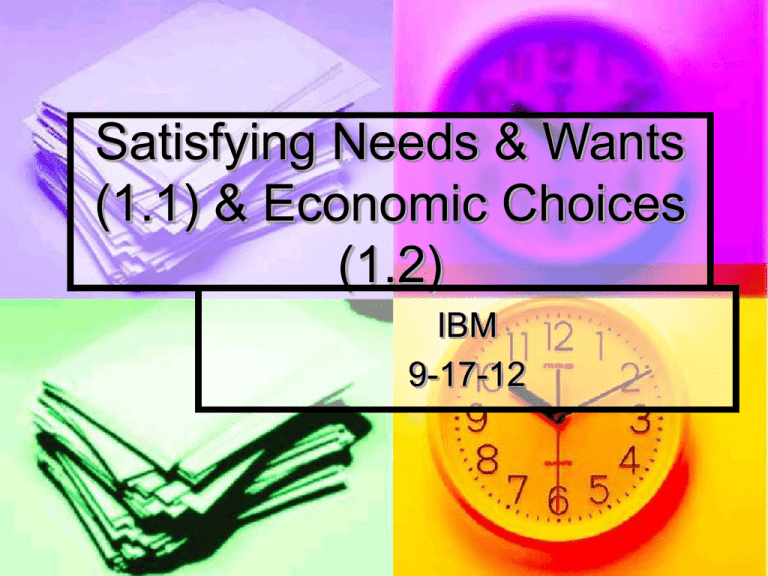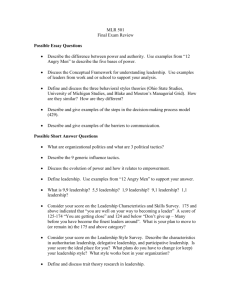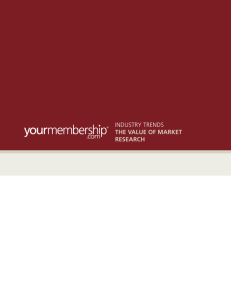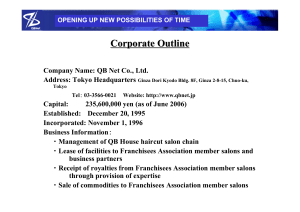Economic Decisions and Systems
advertisement

Satisfying Needs & Wants (1.1) & Economic Choices (1.2) IBM 9-17-12 Warm-up and Objectives Students will learn to distinguish between wants and needs and goods and services. Students will describe the types of economic services Warm-up- What are wants and needs? Is there a difference between the two? Satisfying Needs and Wants Needs- things you have to have in order to survive such as food, water, shelter, & clothing. Ex. salad, water, shirt, shelter. Wants- a want is something that you desire but that you do not necessarily need to live. Ex. Latest fashion, CD, movie, Wii, IPhone 5. Values and Goals Needs and wants are determined by one’s values and goals Values are the beliefs and practices in your life that are very important to you. A goal is a destination, something you want or need, which you acquire by taking certain steps. What are some of your values? Values and Goals Examples of how values, goals, wants, and needs are connected. I value education/ want to make a difference in my community. I also need to earn a living to support myself. Thus, I decided to get good grades, go to college, and pursue a career in Education. Goods vs. Services You may satisfy your needs and wants by purchasing goods and services. A good is something that you can see and touch. Ex. Magazine, pillow, IPad. A service is an activity that is consumed at the same time it is purchased. Services are intangible. Ex. Hair salons, nail salons, Spa, etc. Goods and Services for Business and Consumers Goods and Services can be purchased by business or by consumers. Some goods and services are unique for business and consumers. Some goods and services are similar but meet different needs. Goods and Services Some businesses offer both goods and services. Ex. Rays the Steaks, Hair salons that sale hair products and style clients, nail salons that sell polish and fix nails. Can you name any others? Types of Economic Resources Did you know that the US economy is the largest producer and consumer of goods and services in the world. Few goods and services are free and individuals do not make most of the products and services they consume as they did years ago. So What happens? Types of Economic Resources People use Economic resources to get the goods and services they want and need. Economic resources, also called factors of production, are the means by which goods and services are produced. The three types of economic resources: natural, human, & capital resources. Types of Economic Resources Natural resources are raw materials supplied by nature. Ex. Oil, minerals, nutrients, air, river, lakes and oceans. ALL products you consume begin with one or more natural resources. Think about a can of Chicken Noodle Soup? Which natural resources does it contain? Types of Economic Resources Human resources and the people that produce goods and services. Ex. Farmers raise livestock and crops, factory workers and engineers process and package products, Truck drivers and grocery store employees are responsible for delivering and making products available to consumers. Types of Economic Resources People (human resources) need tools and equipment to convert natural resources into products and services. Capital resources are the money and equipment used in the production of goods and services. Ex. Money, buildings, equipment, & supplies Limited Resources All economic resources are limited so products and services that can be produced are also limited. If resources are used to produce one product they will not be available for the production of something else. Individuals, businesses, & countries compete for access to and ownership of economic resources. Resources that are in high demand, or those that are limited in supply will command higher prices. Closure Activity Name two of your wants and two of your needs. What is the difference between a good and service Does the service industry supply more needs or wants? What natural resources are found near your home? Give two examples of capital and human resources? Economic Choices Students will: Understand the basic economic problem Explain the steps of the decision making process. The Basic Economic Problem Scarcity- Not having enough resources to satisfy every need and want. Scarcity forces everyone to make choices or decisions among the alternatives. Ex. If you earn $75/week and you spend that on a new pair of shoes, then you may not enough for a movie and pizza with friends. Choices, Tradeoffs, and Opportunity Cost Economic Decision Making-process of choosing which wants and needs, among several options, will be satisfied. When you give up something for something else you are making a tradeoff. The opportunity cost is the value of the next best alternative that you did not choose. Choices, Tradeoffs, and Opportunity Cost Ex. You may give up working fulltime to pursue a college degree. If you could make $25K from working $25k is your opportunity cost. Remember that the benefit you get from your choice should always be greater than the benefit from the next best choice. The Decision-Making Process The decision-making process has 6 steps. Define the problem-the problem must be clearly defined in order to make a decision. Identify the choices-it is common for you to face choices with many alternatives. The Decision-Making Process Evaluate the advantages and disadvantages of each choiceits always helpful to write down each choice and the adv. & disadv. to that choice. Chose One-Select the choice that you believe will be the best for you at this particular time. The Decision-Making Process Act on your choice- Once you have selected a choice, do whatever it is that you have chosen. Review your decision-After you experience the results of your choice, it is important to review your choice. DECISIONS YOUR PERSONAL, CAREER, AND FINANCIAL DECISIONS ARE ALL INTERWOVEN. SOME TIMES YOU MAY NOT KNOW THE IMPACT OF YOUR DECISIONS UNTIL SOME TIME HAS PASSED. MAKING NO DECISION IS ACTUALLY MAKING A DECISION, A DECISION TO ACCEPT WHATEVER HAPPENS. Closure Questions True or False-The basic economic problem is that consumers have too many resources to chose from. What is economic decision-making? Describe a tradeoff that you have made recently. Yorktown needs computer for its business program. They are deciding between desktop and laptop. If Yorktown chooses laptops what is the opportunity cost? What is the 1st and last step in the decision-making process? Why should you evaluate the advantages and disadvantages of your choices.



